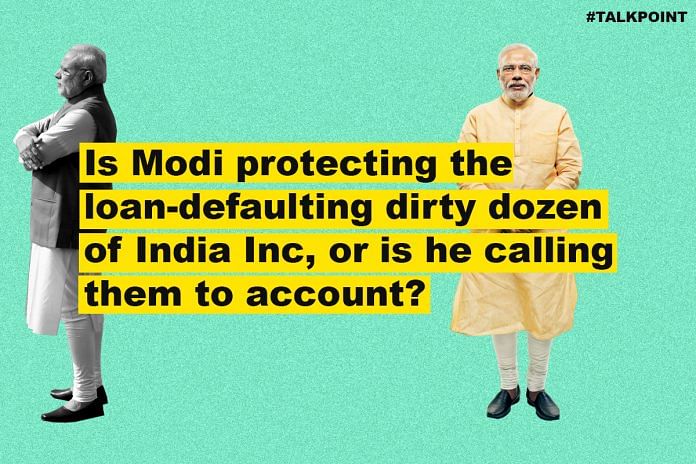Twelve wilful defaulters of corporate India attempted to buy stressed assets, prompting the government to ask banks to be vigilant.
Is Modi protecting the loan-defaulting dirty dozen of India Inc., or is he calling them to account?
The question is, can these wilful defaulters bid for the companies or not?
A wilful defaulter is one who has been siphoning off funds from the company. Like in the case of Adani, there was a 100-page Directorate of Revenue Intelligence notice which clearly showed in graphic detail how he siphoned out money by over-invoicing. The same thing has happened in the case of Sterling Biotech, in which the CBI has registered two FIRs. The problem of non-performing assets (NPA) is also because of this. These people take large bank loans on the basis of over-invoiced bills.
Also, insolvency under this code can be easily created and declared. When you are declared bankrupt, all proceedings against the company come to a standstill. Often, promoters have given their personal guarantees, but they declare bankruptcy without the creditor carrying out the process of recovering the debt from these personal guarantees. Amrapali is one case. Only if the personal asset is found insufficient should you declare bankruptcy.
Here are other sharp perspectives on wilful defaulters:
Rajeev Chandrasekhar, MP
Shekhar Gupta, Editor-in-Chief, ThePrint
Jaithirth Rao, entrepreneur and writer
The insolvency professional or interim resolution professional (IRP) appointed is sometimes their own chartered accountant. In the case of Amrapali, it was Deloitte. Often, these have been complicit in the siphoning of funds, as in the case of Satyam & PwC. They were complicit in allowing Satyam to siphon out the funds. These IRPs will determine what is to be done, who will run the company, and what is to be sold off.
So, this bankruptcy bill is designed, or at least will be used, to protect the bigwigs who have run away with company funds.
First, you must probe if money has been siphoned off. There are cases against big industrialists where shell companies in Singapore have been used to invest money here. It was obvious that money had been siphoned off. But nothing was done. All the bigwigs are being protected.




aren’t the lawyers finding various ways to protect the defaulters trying to look at the loopholes in the laws /ordinances brought by the govt/ why blame auditors /govt . somewhere a starting has to be made. any shortfall in the laws will be addressed with experience in each case. no law can be designed completely fool proof and if done, poor lawyers who are charging lakhs of rupees on hourly basis will have to look for other sources.
Sorry, but I disagree with Mr. Bhushan and other writers — more so after the Insolvency and Bankruptcy Code amendment that bars not only all the willful defaulters. The amendment states that a person shall not be eligible to submit a resolution plan if he/she is:
– Classified as a willful defaulter by RBI
– Connected/Related to the defaulter
– Disqualified as a director under Companies Act, 2013
– Barred by SEBI from accessing capital markets
– Is an undischarged insolvent or convicted of an offense punishable by imprisonment
– Indulged in a preferential/undervalued/fraudulent transaction
– Executed an enforceable guarantee in favor of a creditor
– Whose account has been a non-performing asset for one year or more and who has failed to make payment of all overdue amounts with interest before submission of the resolution plan
This, in fact, bars all promoters of 12 large accounts putting their assets on a sale. It also blocks people related to promoters from making bids for the defaulting company.
The claim that “When you are declared bankrupt, all proceedings against the company come to a standstill” by Bhushan is incorrect. Under the current scenario, when a new promoter takes over, he would get access to all the books and all the assets of the defaulting company. He can pretty much take the original defaulter to court for damages due to bad entries and fraud. The government, in this case, doesn’t have to spend its own resources on investigation and expensive audits that can take years. The argument by Rajeev Chandrasekhar that “first we must probe” is fallacious. Yes, the government too has reserved the rights to a forensic audit for 6 months. However, it is too costly and impractical for the government to finish an audit within 6 months. We know from experience how probes and litigation go in India. We can’t wait for another 2 decades to resolve the 200 billion bad debt problem that is growing in size every day.
I think this is a good step towards cleaning up the mess of bad loans before it becomes so huge that we become another Greece!